When deciding between fingerprinting methods, you'll find two main options: traditional ink prints and Live Scan technology. Traditional ink fingerprinting uses black ink to capture your fingerprints manually, while Live Scan electronically scans and digitizes them. Live Scan offers higher accuracy (up to 99%), faster processing (5-10 minutes), and immediate electronic submission, but comes with higher initial costs. Traditional ink printing is cheaper but takes longer (15-30 minutes) and risks smudging. Your choice should depend on your timeline, budget, and the requirements of the requesting organization. There's much more to factor in when making this important decision.
Key Takeaways
- Live Scan digitally captures fingerprints using electronic sensors, while traditional fingerprinting uses ink and paper cards for impressions.
- Live Scan provides faster results (5-10 minutes) and immediate electronic submission compared to ink fingerprinting (15-30 minutes).
- Traditional fingerprinting is generally cheaper per session but Live Scan offers better long-term value through reduced errors and resubmissions.
- Live Scan achieves up to 99% accuracy and eliminates common issues like smudging and improper pressure found in ink fingerprinting.
- Choose Live Scan for speed and accuracy in background checks and professional licensing; use ink fingerprinting where digital systems aren't accepted.
Traditional Fingerprinting Explained
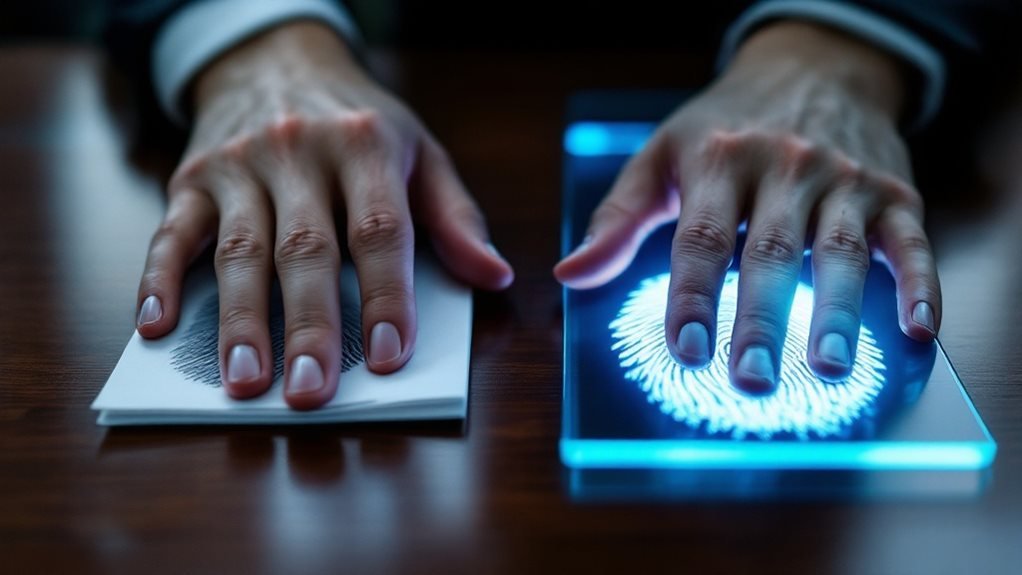
For decades, traditional fingerprinting has relied on ink-based methods to capture unique ridge patterns on a person's fingertips.
You'll typically encounter this process at police stations, government agencies, or employment screening facilities.
The technician will roll each of your fingers in black ink and press them onto a standardized Fingerprint Card, ensuring clear impressions of your prints.
The Historical Development of this technique dates back to the late 1800s when law enforcement first began using fingerprints for identification.
You'll notice the process hasn't changed much since then – your fingers are still rolled from nail to nail to capture the complete pattern.
While it's a tried-and-true method, you might find it messy, and the quality of prints can vary depending on the technician's skill and the amount of ink used.
Live Scan Technology Overview
Since the late 1990s, Live Scan technology has revolutionized fingerprinting through digital capture and electronic transmission.
Instead of ink and paper cards, you'll use an electronic device that scans your fingerprints directly into a digital format.
The process captures high-resolution images of your prints using optical or capacitive sensors.
The device's liveness detection feature guarantees that only real fingerprints are captured, preventing potential fraud through fake prints or spoofing attempts.
When you place your fingers on the scanner's surface, it creates detailed images that are instantly converted into digital data.
This technology allows for immediate quality checks, reducing the need for rescans and guaranteeing your prints meet FBI and state requirements.
If a print isn't clear enough, you'll know right away and can retake it on the spot.
Accuracy Comparison
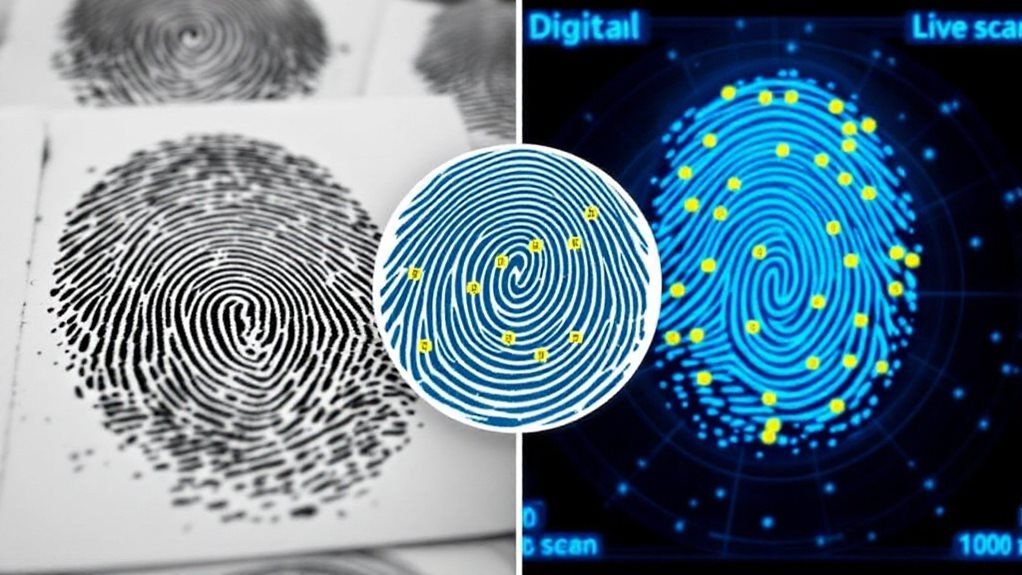
The accuracy differences between traditional ink fingerprinting and Live Scan technology are significant and measurable. While ink prints can suffer from smudging, improper pressure, or incomplete rolling, Live Scan eliminates these common issues through digital capture and instant quality checks.
Live Scan's error reduction capabilities mean you'll get clearer, more consistent prints the first time. The system alerts you immediately if a print isn't captured properly, allowing for instant retakes.
You'll notice superior image clarity with Live Scan's high-resolution digital sensors, which capture minute ridge details that might be lost in traditional ink prints.
When you need prints for employment, licensing, or legal purposes, Live Scan's accuracy rate of up to 99% means you're less likely to face rejection or delays due to poor print quality.
Cost Analysis
Initial startup costs make Live Scan appear more expensive than traditional ink fingerprinting, but long-term savings often justify the investment. You'll need to weigh your budget allocation carefully when choosing between the two methods.
While ink fingerprinting requires minimal upfront costs for ink pads and cards, Live Scan systems typically cost between $10,000 to $20,000 for equipment and software.
The financial implications extend beyond initial expenses. Live Scan eliminates recurring costs for ink, cards, and storage supplies. You'll also save on labor costs since digital prints require less time to capture and process.
If your organization processes more than 100 prints monthly, Live Scan's efficiency can offset its purchase price within two years through reduced materials and labor expenses.
Processing Time Differences
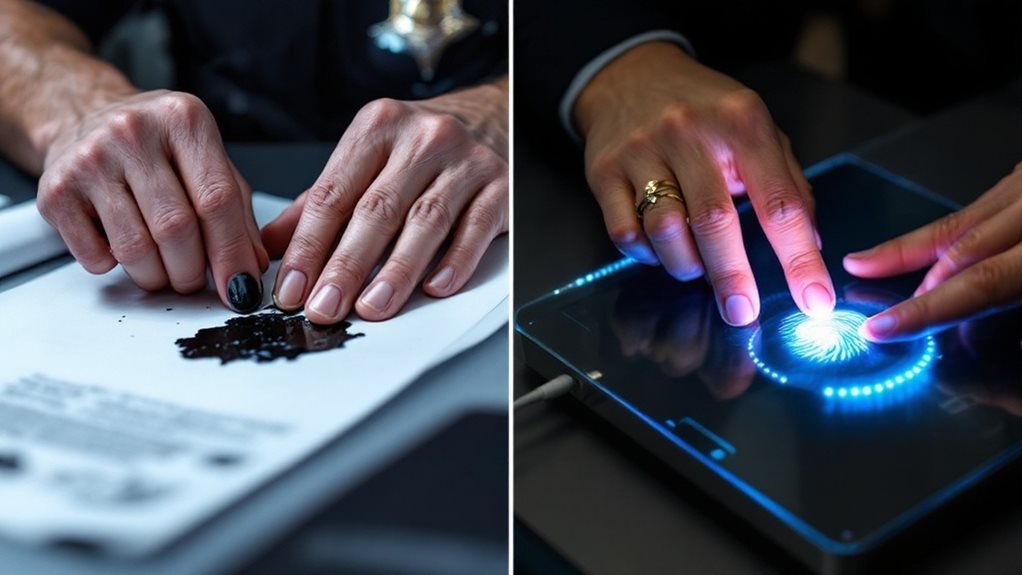
How much time could you save by choosing Live Scan over traditional fingerprinting? The difference is substantial when you compare the rapid processing capabilities of digital scanning to traditional ink methods.
With Live Scan's expedited results, you'll experience drastically shorter processing times.
- Results typically arrive within 24-72 hours, compared to 4-6 weeks with traditional fingerprinting
- The actual scanning process takes just 5-10 minutes, while ink prints can take 15-30 minutes to complete
- If there's an error in the scan, you'll know immediately and can rescan on the spot, rather than waiting weeks to learn about rejected prints
You'll save valuable time by choosing Live Scan, making it particularly beneficial when you're facing urgent employment or licensing deadlines.
Required Documentation
Preparing for your fingerprinting appointment requires specific documentation, regardless of whether you choose Live Scan or traditional methods. You'll need to verify your identity and show authorization for the background check process.
| Document Types | Identification Requirements |
|---|---|
| Primary ID | Valid government-issued photo ID |
| Secondary ID | Social Security card or birth certificate |
| Authorization Forms | Agency-specific request forms |
| Payment Documentation | Receipt or payment voucher |
Before scheduling your appointment, you'll want to gather all necessary paperwork to avoid delays. For Live Scan services, you'll typically need a Request for Live Scan Service form with your case number and ORI (Originating Agency Identifier). Traditional fingerprinting may require additional documentation from your requesting agency, so it's best to confirm requirements beforehand.
Common Uses and Applications
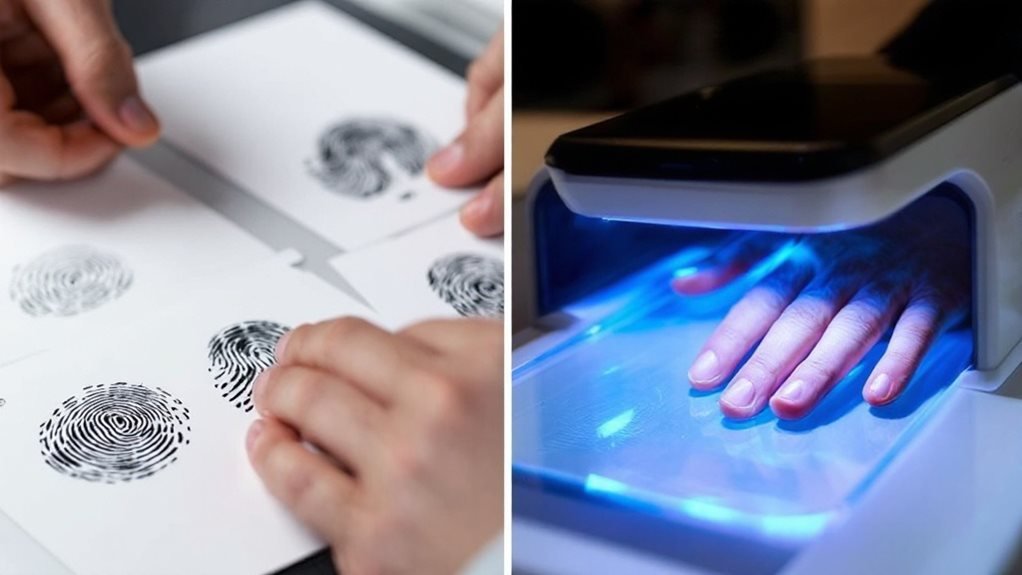
Fingerprinting serves numerous essential purposes across various industries and institutions.
You'll find both traditional and live scan methods being used for Identity Verification in critical situations where confirming someone's identity is paramount.
From employment screening to international travel, these methods help maintain security and compliance.
Common applications include:
- Background checks for employment in sensitive positions like healthcare, education, and government roles
- International Applications such as visa processing, immigration procedures, and overseas employment verification
- Security clearances for military personnel, contractors, and individuals accessing restricted facilities
You'll likely encounter fingerprinting requirements when working with children, handling sensitive information, or pursuing professional licenses.
The method you'll need often depends on your specific situation and the requesting organization's requirements.
Legal Requirements by State
While fingerprinting applications remain consistent nationwide, the specific legal mandates vary substantially by state.
You'll need to check your local requirements, as State Variations can affect whether you need traditional fingerprinting, live scan, or both.
Some states require live scan for all employment-related background checks, while others accept traditional ink fingerprinting.
Jurisdiction Limitations play a pivotal role in determining which method you must use.
For example, California mandates live scan for most professional licenses and certifications, whereas Texas still accepts traditional fingerprinting for many purposes.
If you're applying for positions in multiple states, you may need to complete different fingerprinting methods to comply with each state's regulations.
Contact your state's relevant licensing board or employer to confirm current requirements.
Privacy and Security Considerations
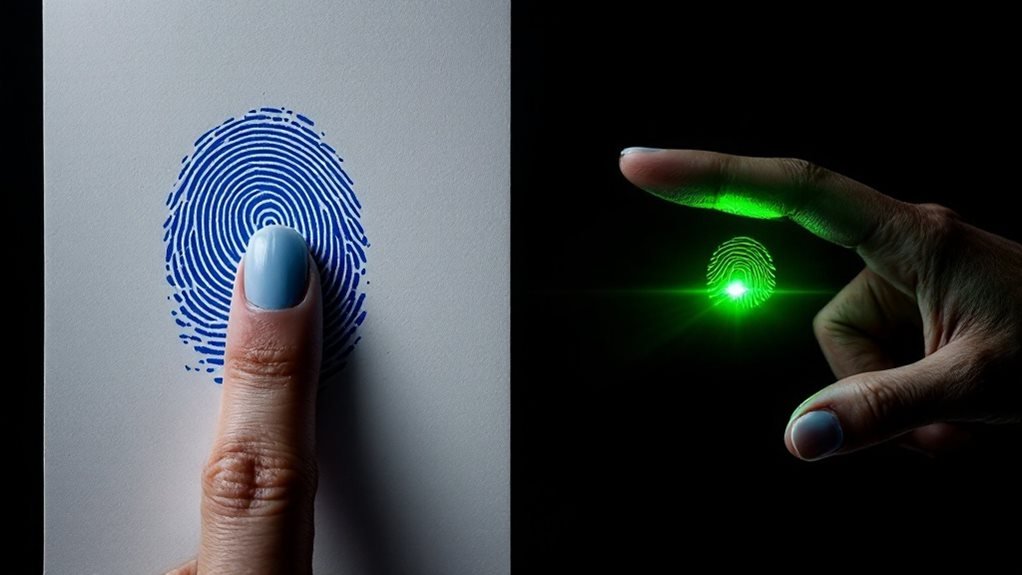
How secure are your biometric details during the fingerprinting process? Both traditional fingerprinting and live scan systems have strict protocols to protect your data from misuse and unauthorized access. However, live scan typically offers enhanced security features and encryption methods.
When considering privacy and security, you should be aware of these key factors:
- Live scan systems automatically encrypt your fingerprints before transmission, while traditional ink prints may require manual handling that increases exposure risk
- Both methods must comply with federal regulations protecting against biometric surveillance and unauthorized data sharing
- You retain the right to know how your fingerprints will be used, stored, and eventually destroyed
It's important to verify that your fingerprinting provider follows industry-standard security protocols and maintains proper certifications to handle biometric data.
Choosing the Right Method
Selecting between traditional fingerprinting and live scan depends on several practical factors that impact your specific situation.
Consider your timeline, budget constraints, and the requirements of the requesting organization. If you're submitting prints to a government agency, they might specifically require live scan technology for faster processing and enhanced accuracy.
Your volume of fingerprinting needs will influence scanner selection. For occasional prints, traditional ink methods might be cost-effective.
However, if you're processing multiple prints daily, investing in live scan equipment could save time and reduce errors. The digital shift is particularly important for organizations handling large quantities of background checks or identity verifications.
You'll also need to evaluate your technical capabilities and whether you have staff trained to operate digital systems effectively.
Frequently Asked Questions
Can Fingerprints Be Taken if Someone Has a Bandaged or Injured Finger?
If you have injured fingers or bandaged digits, you'll need to wait until they heal before getting fingerprints taken. Alternatively, technicians can document the injury and collect prints from your other available fingers.
Do Certain Medications or Skin Conditions Affect Fingerprint Quality?
Like a fading photograph, your fingerprints can be affected by medications and skin conditions. If you're undergoing chemotherapy effects or experiencing dermatosis impact, you'll likely have temporary changes in your fingerprint quality and clarity.
Are Fingerprint Records Automatically Deleted After a Certain Period of Time?
Your fingerprint records won't undergo automatic deletion. Fingerprint retention policies vary by jurisdiction and agency, but most law enforcement databases permanently keep these records unless you specifically request and qualify for expungement.
Can Children Get Fingerprinted, and What Are the Age Requirements?
Better safe than sorry! You can get your child fingerprinted at any age – there's no minimum requirement. However, legal requirements vary by state, and some programs offer age exceptions for special circumstances like child ID protection.
Are Fingerprint Technicians Required to Have Special Certifications or Licenses?
You'll need specific certifications to become a fingerprint technician. Most states require fingerprint technician certification and live scan certification requirements. Check your state's licensing board for exact training and documentation needed.
Conclusion
Whether you need fingerprinting for employment, licensing, or legal requirements, you'll want to choose the method that best fits your situation. Live scan offers speed, accuracy, and digital convenience, while traditional ink fingerprinting provides affordability and widespread availability. Consider your timeline, budget, and state requirements—then make your choice with confidence. You'll find either method can effectively verify your identity and help you move forward.

